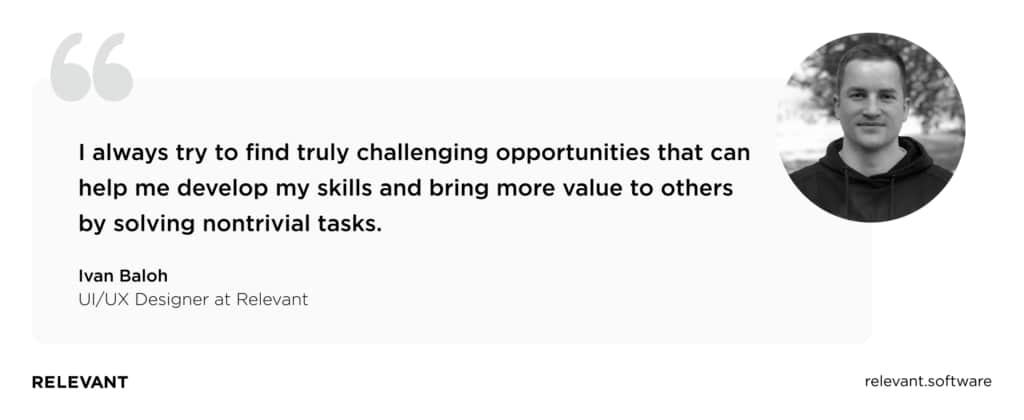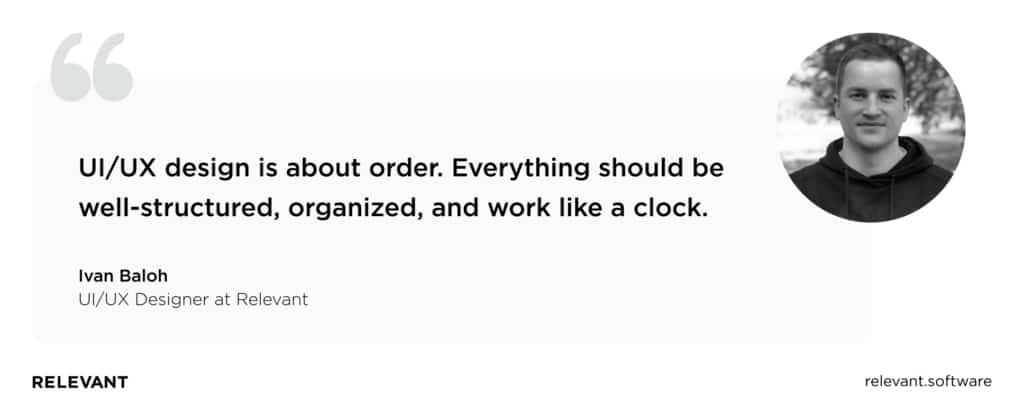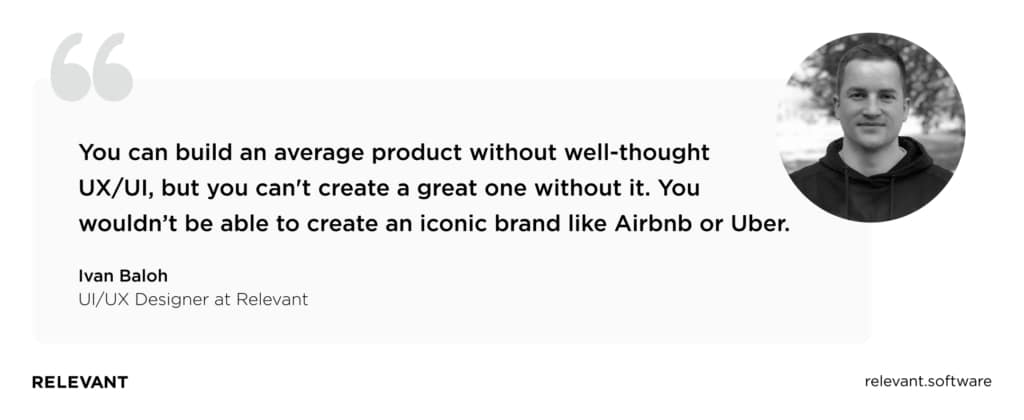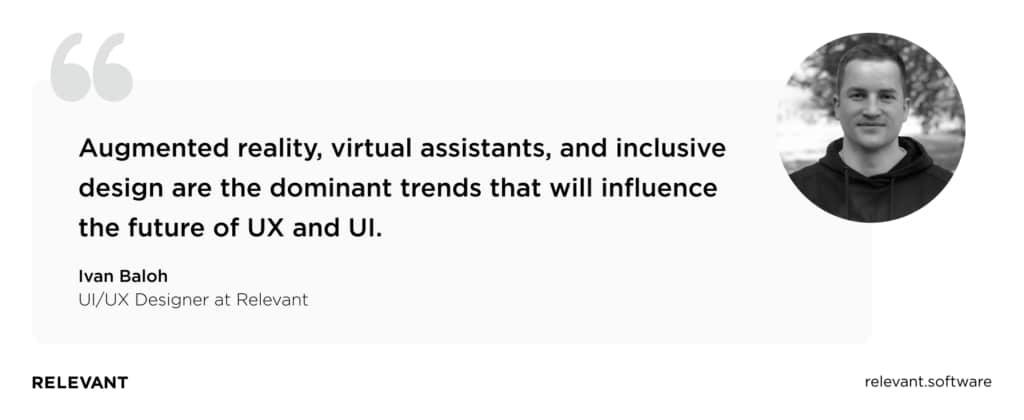10 Questions with Relevant’s UX/UI Designer
UI/UX design is no longer a luxury, but an essential part of every smart business strategy. It doesn’t really matter what industry you work in, it is a good design that helps your company stand out, find new customers, engage, and retain your users in the long run.
Just think about it, around 90% of users won’t return to a site if they had a bad experience with it. And at the same time, the ROI of UX is unbelievable. We can safely say that it is the UI/UX that now determines your failure or success in the highly competitive business world.

We provide companies with senior tech talent and product development expertise to build world-class software. Let's talk about how we can help you.
Contact usSo whether you planned it or not, if you are doing business online, you should probably hire a UI/UX designer right now. But what you, as an entrepreneur, should know about this role? What is UI/UX all about?
To answer these questions, we talked to Relevant’s UI/UX designer Ivan Baloh. Among other things, we discussed his work, the best UI and UX practices, why UI/UX design is so vital these days, and, of course, where the industry is heading.
Table of Contents
1. Tell us a little about your background? How long have you been working as a UI/UX designer?
Before I started my journey in IT, I had been working in the military. When my contract ended, and I was trying to figure out “what’s next,” my friend asked me to help her with user testing of the project she was working on at that time. It was a web app that allowed people to buy and exchange books. While testing that app, I became interested in how it all really works and decided that it would be interesting to help create apps like this one, that looks great and is easy to use. This is where the idea of becoming a designer first came into my mind.
Later, of course, I found the relevant design courses, and then the first job came along. The design for me, in a way, reflects the things I’ve always wanted to try but haven’t had the chance to. So I guess if you want something really bad, even subconsciously, the right opportunity will find you.
I’ve been working as a UX/UI Designer for about three years, and I have experience in creating designs for various products and niches. Each of the projects I worked on is important to me because it taught me a lot. When choosing a new workplace or a project, I always try to find truly challenging opportunities that can help me develop my skills and bring more value to others by solving nontrivial tasks. Here, at Relevant, I have plenty of options like that.

2. What is the most exciting thing about your work? What drives you the most?
Basically… everything. I feel like everything is great about the work of a designer. But the most exciting thing might be the challenge to understand the client’s ideas and translate them into a visual interface while keeping the users and their needs in mind.
Each project is unique and requires a different approach, but there is a universal skill that I believe every UI/UX designer should master. I am talking about the design thinking process, the method that allows understanding what users need, solving the most complicated challenges, and delivering the most delightful experience. So the application of design thinking practices is another thing that I love a lot about my job.
Speaking of drivers, I am very motivated by the result. It is vital for me to contribute, to be a part of the team that molds customer experiences, implements great ideas, and builds superb products. This is what drives me the most.
3. Can you tell us about your most complicated project? What was challenging about it, and how did you tackle that challenge?
When I was a junior specialist, I worked in a team developing a beer sales app. It was one of the most creative, most complex, and most exciting projects at the same time. The idea itself, an app for selling beer, might sound trite, but the implementation and the outcome were pretty spectacular. One of the biggest challenges was to create a character for each sort of beer that would reveal “the character” of the drink.
And an even more complicated task was to build a sort of social network for beer lovers where they could discuss the relevant topics, share experiences and win the seller’s merch. It was a very complex task which we delivered successfully with the help of a deep analysis of the market, an out-of-the-box approach, and human-centered design practices.
4. Most people consider your profession creative. Is it?
Sure. But there is a common misconception that a designer’s job is all about creativity. It requires creativity, no doubt about it, but one has to have strong analytical skills to be a UI/UX designer. While creating a visually attractive design matters, the most critical part of our job is to create an easy-to-navigate and use interface, and ensure the best experience for all the users.
UI/UX design is also about order. Everything should be well-structured, organized, and work like a clock. This is what I like about UI/UX design, and this is where I believe my military background is particularly helpful.

To create that order, you should know the theory well, you should be able to analyze, apply the existing patterns, generate new ideas, and implement them with the help of various techniques and tools. Analytical skill is particularly important for UX designers. What I mean is that the UI and UX functions are often performed by a single person, and this specialist sort of wears two hats and works both with the conceptual part and the visual solutions. But these are actually two different jobs.
UX design is about the user experience and interaction with the product or service, while UI design is about translating these insights into beautiful concepts and the actual design.
5. How do you organize your work? What tools and practices do you use to work on your projects?
The way the designers organize their work very much depends on the project. If the task is to design a product from scratch, the design thinking method is applied. In short, design thinking is a human-centered approach based on empathy that helps to reveal the users’ needs. It consists of a few stages, such as Empathize, Define, Ideate, Prototype, Test, and Implement.
At the first stage of this process, you have to find answers to important questions: Who are your users? What do they care about? How does this product/feature fit into their lives? What motivates or scares them? Why and when do they feel frustrated? To do this, we conduct user interviews, create user personas, work on empathy mapping, etc. So it is the methodology of design thinking that defines the organizational structure of the design creation. For example, until we have answers to all essential questions about the users, we won’t start working on the prototype.
There are also a large number of tools that help to organize designers’ work most effectively, like Jira, Notion, or Trello, and sometimes even a simple notepad to prioritize your tasks.
6. Where do you find inspiration? Can you describe your creative process?
I believe that designers can become inspired “accidentally,” for example, by a beautifully designed interface they’ve come across while searching the internet. But of course, there are many sources created particularly for UI/UX designers that help us stay motivated.
In terms of UX, I often seek, I wouldn’t call it necessarily inspiration, but rather information and solutions on the NN Group site, which is a leading consulting firm in the UX field. I can also recommend an online magazine UXmatters, which provides the most relevant insights—and, yes, inspiration—for UX designers.
As for UI, inspiration comes from many sources. These include such resources as Dribbble, Behance, Awwwards, as well various relevant groups in socials.
7. Why do you think UI/UX is important for business?
UX/UI design ensures that you really understand your user and your product. It helps design an app in a specific way, which makes users comfortable, happy, and satisfied. This inevitably translates into many benefits for business, such as loyalty, a stronger brand, and higher revenues.
You can build an average product without well-thought UX/UI, but you can’t create a great one without it. You wouldn’t be able to create an iconic brand like Airbnb or Uber. The first has more than 50 designers, and the design team of the second one exceeds 70 people. The success of these well-known companies wouldn’t be possible without great UI/UX design. Good UI/UX means good business.

8. How would you define the role of a UI/UX designer in the project?
It varies. It depends on the project and the stage since a designer has been involved. But generally speaking, the key role of a UI/UX designer is to enhance users’ interaction with the product. To what extent you can achieve this goal depends on various factors, starting from the designer’s experience and skills to the number of resources a client is ready to invest.
9. What are the essential skills of a great UI/UX designer? How do you develop your skills?
Except for a solid set of hard skills every UI/UX designer should have, I would also single out the ability to communicate. Communication skills help designers do their job well – gather the necessary information, describe the product clearly, build relationships with the team, with clients, etc.
I think it is critical for a designer, just like any IT specialist, to constantly develop their skills to stay competitive and bring more value to clients and the users of their products.
There are actually many proven methods to do it, such as practicing daily, working on various types of projects, mastering new tools, investing time in education through, for example, online programs (and then implementing the new knowledge), and definitely asking for feedback (from colleagues or publishing your works on relevant platforms).
Another great way to learn is by staying updated on the UX/UI design trends.
10. In this regard, can you please mention 3 major trends that UI/UX design will lean towards in the coming years?
Well, nothing is certain. Because the tech world is changing so fast, it is really hard to predict what will happen next month, never mind the coming years. But I will try.

I guess dominant trends that will very much influence the future of UX and UI are:
- Augmented reality. Hundreds of millions of people are using AR, and this number will only rise. There are thousands of AR apps, and with so many brands betting on this technology, the bright future of AR is unquestionable. Designing for AR differs from creating a design for other projects, so designers should be ready to embrace new skills to keep up with the times.
- Virtual assistants. The smart speakers market is booming too. A growing number of people are using virtual assistants in their everyday lives, which means that more interfaces and more user interactions with such products are not far off. While the common best UI/UX practices will still be applicable for designing virtual assistants, this task will require more attention to particular aspects, and we should be ready for that.
- Inclusive design. The inclusivity of design means that everyone can easily use it, never mind their gender, age, or disability. In the modern world, inclusive design serves as an indicator of the company’s professionalism that builds the product. I think that in the coming years, more and more design agencies will increasingly adapt to this requirement.
Of course, this is not the full list of UI/UX trends, but these are the key ones that I think will make waves in the UI/UX space soon.
Our core services:
Do you want a price estimate for your project?
Do you know that we helped 200+ companies build web/mobile apps and scale dev teams?
Let's talk about your engineering needs.
Write to us











